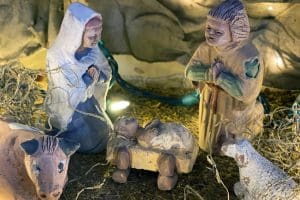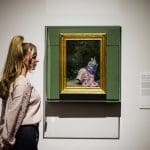![]()

Something significant is happening. Religious art of superior quality is seeing a groundswell among the Latter-day Saints. Beginning with this column, Meridian brings you Steevun Lemon, who will be writing each month on a second Renaissance of spiritual art and highlighting significant Latter-day Saint artists.
The recent release of the movie, The Passion of the Christ has created no small stir, polarizing members and church groups alike. Regardless of your opinions concerning the movie, it is clear that the world is collectively thinking more of the Savior today than it did even a few short weeks ago. This groundswell of religious thinking has a shadow in the events that occurred across Europe seven hundred years ago.
Most of the people living in Europe at the end of fourteenth century spent their lives in the labors of the day. They planted and harvested, they bought and sold; they laughed and they lived with little thought to events unfolding around them. Yet it was those things they did not notice that forever shaped the world and changed the way you and I think today.
Many of us, too, spend our lives on the cares of our day with little thought to the momentous events unfolding around us. We may miss those seemingly insignificant events that will shape the thinking of future generations. If we are to see things as they really are, we must step back from the world and step forward in faith. It requires humility and the eyes of the Spirit if we are to sift the things of little importance from those of eternal value.

This past March found me in Rome on a business trip. My wife joined me at the end of my stay and we took a week to see Italy. I had been so focused on the business portion of the trip, I found it difficult to make the transition to tourist, a flaw my wife is all too familiar with. As we arrived in Florence, I was tired and ready to be done with Italian culture, but since my vacation checklist called for a visit to see Michelangelo’s “David,” there was little choice but to endure yet another museum.
 I dutifully bought the guidebook, mustered up my courage, and started the tour. “David” is the final stop in the museum, and as I turned that last corner nothing could have prepared me for what I saw. It was as if I was staring at something heavenly, something that didn’t belong on this earth. As I looked, all of my tiredness melted and something inside of me changed.
I dutifully bought the guidebook, mustered up my courage, and started the tour. “David” is the final stop in the museum, and as I turned that last corner nothing could have prepared me for what I saw. It was as if I was staring at something heavenly, something that didn’t belong on this earth. As I looked, all of my tiredness melted and something inside of me changed.
I imagined myself in Florence on the day Michelangelo unveiled “David.” The square was packed with people, but it was the people who stayed home that I thought about. In hindsight, we would give up almost anything to have stood on that square on that day. Yet, though it was offered freely, most who lived at the time chose instead to spend their time on things that, although pressing, were of little worth. With this thought I began to wonder.what was I spending my life on?
I recognized that we were in the midst of a second Renaissance-one that will prove more powerful than the first. And just as before, most people are unaware that anything is happening.
Keys to the Renaissance
From its earliest scratchings, art has sought to communicate and take the viewer to places and times unreachable through other means. The artists of the Renaissance were no exception. Artists like Leonardo DaVinci, Raphael, Botticelli, Donatello, and Michelangelo focused on scriptural events and transformed the way the world viewed the Bible. Who can look at the Sistine Chapel and not come away with a lasting image of the creation as God touches the finger of Adam?

One need not suppose that these artists were angelic or that their benefactors were perfectly pious, but one cannot dispute that the artwork they created was inspired. Though their personalities and passions ran from fiery to fearful, the wonder of the renaissance lies in their unified desire to use their talents to portray the divine.
Upon further reflection we see that three keys were necessary to bring about the Renaissance. First, an economic model that supported the production of art; second, artists with world-class talent; and third and most important, inspiration from the Holy Ghost.
Economic Model of the Renaissance
In the fourteenth century, a group of powerful Florentine families rose in prominence and power. The Medici family was among this group, rising to become one of the leading banking families in Europe. The Medicis spent their new-found wealth on the arts, becoming the primary patrons to Leonardo DaVinci, Botticelli, Donatello, and Michelangelo.
While the Medici patronage began by commissioning and paying for artwork in advance, in time their support grew in intensity and duration. Lorenzo de’Medici found Michelangelo at fourteen years old in the art schools of the day and adopted him into the Medici family. Michelangelo received living quarters, food, and all of the other necessities of life. His time thus became fully devoted to the study and creation of art.
The Medici support allowed many artists to create in an environment largely free from the worries of earning a scant maintenance. They could create without thought of how to provide food and shelter for themselves and their families. It is true that the crucible of necessity can produce amazing results, but the ability to create free from distractions and worries is necessary for the full influence of the Spirit to work.
Revolutionary Talent
The artists of the Renaissance pushed the envelope of the known art world. They shattered the two-dimensional portraiture of the Dark Ages and began experimenting with three-dimensional perspective. Their artwork moved far beyond storytelling and focused on the emotion and realism of the moment. Who can look at the paintings of Michelangelo without imagining for a moment that you have stumbled upon the scene as it might have happened?
The pursuit of realism drove artists like Leonardo DaVinci and Michelangelo to open the human body and explored the inner workings of human anatomy. It drove those like Bernini and others to sculpt the human form with an exactness and perfection unseen to that time. Their achievements were revolutionary; they broke new ground and explored new techniques that changed artwork forever.
They were the best in the world, unrivaled by any others before them and by few since. Without the advances they pioneered, the Renaissance would not have had the lasting impact on those that viewed the paintings then or view them now. Without perspective, lighting, and realism the artwork of their day would have remained as little more than unknown altarpieces and murals dotting the Italian landscape.
Inspiration of the Holy Ghost
The former keys are meaningless without the illumination of the Spirit. While it is true that artists may produce masterpieces of various subjects, it is those subjects that stir our souls and cause us to contemplate our Creator that make the greatest difference. By and large, these artists choose to paint and sculpt the life of the Savior. They portrayed the stories of the Bible-the Last Supper, the Crucifixion, and the Resurrection. They spent their days bearing testimony to the greatness of God and the divinity of His Son. They were not without imperfections, but their lives were filled with faith.
There will be those who read this that argue against the character of these artists. They will cite an obscure source to prove that they were less than perfect and could not therefore create masterpieces of piety. To them I reply with a reference from Mark Twain’s classic novel, Huckleberry Finn:
I about made up my mind to pray, and see if I couldn’t try to quit being the kind of a boy I was and be better. So I kneeled down. But the words wouldn’t come. Why wouldn’t they? It warn’t no use to try and hide it from Him. Nor from ME, neither. I knowed very well why they wouldn’t come. It was because my heart warn’t right; it was because I warn’t square; it was because I was playing double. I was letting ON to give up sin, but away inside of me I was holding on to the biggest one of all. I was trying to make my mouth SAY I would do the right thing and the clean thing.but deep down in me I knowed it was a lie, and He knowed it. You can’t pray a lie – I found that out. [1]
Neither can you paint a lie. An artist may fool a few for a time, but the art will inevitably reveal its creator. One needs look no further than the works of the Renaissance to ascertain the true character and nature of its creators. Enough said.
Second Renaissance
Like so many things in life, we sense some things before we can prove their existence. In the art world there are rumblings surrounding religious art that can only be compared with a second Renaissance. As with the first Renaissance, all of keys are now present. We see the emergence of a viable economic model that supports the arts, a group of LDS artists recognized among the best in the world, and the inspiration of the Holy Ghost moving upon these artists to create the masterpieces of tomorrow.
Shifting Economics of Art
To understand the changing economics behind art requires an understanding of the way art is experienced. Although Gutenberg built his printing press in 1436, the ability to reproduce art would have to wait for another 250 years.
With the advent of lithography, artists now had the ability to produce thousands of copies of a single image. This expanded reach came at a price. The days of wealthy benefactors commissioning great works of art dimmed. Commissions like the Sistine Chapel, Michelangelo’s “Pieta”, and the works of St. Peter’s Basilica were replaced with a focus on producing artwork that appealed to a mass audience and thereby garnered economic support.
The masses clamored for more traditional landscapes and other innocuous subjects, leaving religious art to wane. Increasingly, world’s best artists turned their attention to filling demand rather than creating religious masterpieces. The LDS market was no exception. Many LDS artists focused their attentions on more popular genres and away from religious subjects.
In the LDS art market, the base of consumers is only now beginning to emerge. To see how this market has develop requires us to step back and look at the artists that pioneered LDS art. Giving a brief history of anything runs the same risk as making a speech at the Oscars, you are inevitably going to leave someone out and hear about in the morning. My disclaimer is that this list is not intended to be exhaustive, but rather to give a few of the mileposts along this journey.
Latter-Day Saint Arts

Any discussion of LDS art begins with an artist who was not a member of the Church, but who has changed the way we view the Savior forever-Carl Bloch. Born 1834, Carl first achieved notoriety when the King of Denmark commissioned him to paint his Praying Chamber after it was destroyed in a fire. From this commission emerged his collective works on the life of the Savior. These paintings have made up the staple of LDS images and most have been printed and distributed by the Church for decades. Bloch was the last major religious artist to operate under the patronage of a wealthy benefactor.

The first LDS artist on any history of LDS arts is Carl Christensen A. Christensen. Born in Denmark in 1832, C. C. A. Christensen joined the Church when he was eighteen years old. After returning from a mission to his homeland he immigrated to America and pulled a handcart to Utah.
A self-taught artist, his greatest contribution was his Mormon Panorama-a collection of 22 paintings depicting the history of the Mormon experience. C.C.A. Christensen did not enjoy the luxury of a patron. He painted in his spare time while tending to the chores of the day. He spent his life touring various congregations and displaying his paintings, but during his lifetime his works never moved beyond the immediate circle of Saints here in the West.
Recognizing the need for arts in the Church, Brigham Young called a team of artisans to France to study the arts and architecture of Europe. One of these men, Truman O. Angel, went on to design the Salt Lake Temple and others of the company painted the murals in the early temples.

Although the Church did not provide this ongoing patronage for artists, it set a precedence of the importance of arts and served to inspire up and coming LDS artists. One of these artists was Minerva Teichert.
Born in 1888, Minerva studied at the Art Institute of Chicago. Upon the advice of her mentor, she undertook to paint the history of the Mormons. Her paintings were the first collective work to depict Book of Mormon events. Following in the footsteps of the early church artisans, her crowning work is the mural in the World room of the Manti temple. Today, Minerva’s paintings are among the most avidly collected early Mormon works, but the market did not exist for her. She sold few of her paintings during her lifetime, and gave most away to friends and family.

In the early 1950’s, Arnold Friberg was commissioned to create a set of paintings depicting the major events of the Book of Mormon. These paintings became the bedrock of LDS art and have shaped the way members of the Church see the Book of Mormon. For example, when I say, “Abinadi” what pops into your mind? Is it the fat King Noah with his plume of feathers and the leopard at his feet with the bearded Abinadi standing in chains before him? This is the power of art-it does not just shape, it creates the way we see the world.
In the ensuing years there were many artists including, Del Parsons, Robert T. Barrett, and Al Rounds who further explored the Mormon experience. They were among the earliest pioneers to publish and sell art specifically for the LDS community. The volume was small and limited to a small geographic area, but this work laid the foundation of the consumer economic model that would support LDS arts in the future.
Today, we see the fruits of those early pioneer’s labors. Even five years ago it was difficult to find any LDS artwork for sale outside the Church Distribution system. Now you cannot enter an LDS bookstore without finding the walls covered in world-class LDS art. This increasing consumer demand is fueling the economics of art and making it possible for ever-increasing numbers of LDS artists to migrate from more traditional art pursuits into religious artwork.
World Renowned Talent

In the1980’s, Greg Olsen began painting the life of the Savior. Greg’s talent was recognized nationally in the Christian market and he was one of the first LDS artists to be carried by a national publishing house. His depictions of Christ are among the most recognizable in the LDS community. His image, “O’ Jerusalem “, has sold more copies than any other commercially produced piece of LDS art to date.
In the early 1990’s, Liz Lemon Swindle left a promising career in wildlife art and began painting children. Two years later she began a series of paintings depicting the life of Joseph Smith. This body of work created something different in religious art. She focused on the people in our shared history, allowing us to see ourselves in characters that had been distant and two-dimensional before. Her painting of Joseph cradling his infant son, “While Emma Sleeps,” brought Joseph Smith out of the shadows and into our living rooms.

Then there were LDS artists like James Christensen, Chris Young, Robert Marshall, Jeffrey Hein, and others whose talents gained them national followings, but whose hearts kept them painting religious topics when there was little interest. Today, we take for granted that there is an LDS art community. We forget that even a few short years ago, LDS artists gave away more paintings than they sold and few were known outside the confines of the Western United States.
These LDS artists and many others are nationally known and recognized among the finest artists in the world today. They are creating art that is not just good LDS art; it is exceptional in its own right.
Inspiration of the Holy Ghost
From these early pioneers and countless others has emerged the vibrant and growing LDS art community. Every week I hear of new artists who have chosen to move away from their respective genres and join their fellows preaching Christ through art. This growing swell of nationally known and recognized artists is shaping the face of the spiritual landscape just as Michelangelo, Leonardo DaVinci, and others did seven hundred years ago. Who can doubt when they look at the works of these artists that they are inspired?
As I stared at the “David” last March, I realized that I wanted more than just a good job in this life. I wanted to be part of this second Renaissance and focus on the beautiful and the exalting. I wanted to abandon the pressing cares of the day, drop everything, and rush to the square to see the next Michelangelo. I invite you to join me.


















